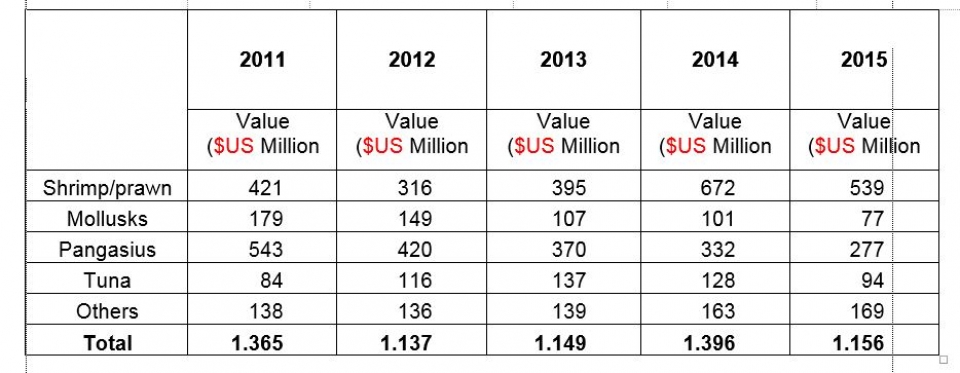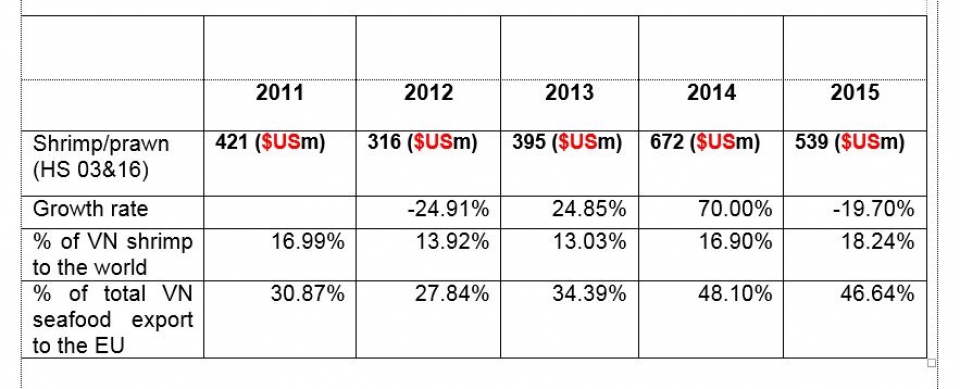Vietnam fishery and aquaculture import and export: lack of sustainability, evidence with numbers
Below graph illustrates the trade flows between Vietnam and the EU, in which two-way trade has increased by more than 5 times from 2005 to 2015. For many years, the EU has been the third biggest trading partner (after China and the US) and the second top export market for Vietnam products (Eurostat, 2016).
 |
| EU trade flows and balance with Vietnam: 2005-2015 (source: Eurostat, 2016). |
Key products exported from Vietnam to the EU include those where the higher competitive advantage is most prevalent, such as textiles, footwear, coffee, seafood and IT goods. Among other products, aquaculture has created the most important value flow of the total food trade between Vietnam and the EU. Fishery exports transferred approximately $US 1.2 billion in the last years from Vietnam to the EU, and accounted for 17.6% of total Vietnam seafood export value. Below table illustrates that evolution:
 |
| Structure of Vietnam exported fishery products to the EU by value: 2011-2015. Source: GDVC, 2016. |
Aquaculture accounts for the most important value flow concerning food exchange between Vietnam and the EU. Aquaculture exports represent a great proportion of the total export value from Vietnam to EU member markets, particularly Germany, Italy, Spain, the Netherlands, the United Kingdom, France, and Belgium. The two main aquaculture product lines are shrimp and catfish which account for around 45% and 25% respectively of total fishery export value.
However, currently Vietnamese exports of aquaculture products still face many difficulties and challenges, such as stronger competition, strict application of technical barriers to trade measures, food safety management and anti-dumping measures of import countries. According to GDVC (2016), shrimp exports to the EU decreased by 18.7% in value to $US 539 million in 2015, and the same pattern applied to pangasius and tuna (which decreased by 16% and 27% respectively).
 |
| Vietnam shrimp exported to the EU: 2011 – 2015. (Source: GDVC, 2016 and the author calculation). |
Shrimp has accounted for a big part of Vietnam seafood exports to the EU and its market share has increased from 30.87% in 2011 to 46.64% in 2015 of the total seafood export to the EU and from 16.99% to 18.24% of the total Vietnamese shrimp exported to the world accordingly. However, the growth rate evolution seems not sustainable because while it dropped by 24.91% in 2012, it recovered in 2013 by a rise of 24.85% then surprisingly climbed up to 70% in 2014 then again dropped in 2015 by 19.7%. The fluctuation of shrimp exports to the EU also raises the concern of sustainability for this sector.
Currently, shrimp of Vietnam with “wholly obtained” origin enjoys a GSP preferential tariff rate which is not applicable to other countries such as India. Therefore a sharp increase of live/fresh/frozen shrimps imported from India to Vietnam (+30%) and accordingly a surprising increase of processed shrimp exports from Vietnam to the EU (+70%) in 2014 could create an issue of mis-declaration of rules of origins for shrimp “wholly obtained” of Vietnam destined to the EU.
In addition, food safety is the issue that Vietnam’s fisheries exporters still have to tackle effectively due to an increase in food safety warnings from importing countries about potential contamination of seafood products. Recently, Vietnam’s fishery sector has suffered huge losses resulting from the death of fish along the country’s central coast due to the contamination of waste water from a Taiwanese steel manufacturer (Tuoitrenews, 2016). This was an environmental disaster for the Central coastal area as well as the aquaculture community in this region. Recently, many safety alert notifications have been issued by the EU concerning seafood imports from Vietnam which contributed to a higher rate of seafood shipments being rejected in the EU (Tuoitrenews, 2016).
In order to improve the capacity of aquaculture exports, Vietnam needs to apply comprehensive economic and technical solutions and pay particular attention to the enforcement of importers’ regulations on food safety and traceability.
Finally, sustainable development requires Vietnam’s policy makers to adopt a detailed roadmap for implementation of the Master Plan and adjust targets regularly to adapt to change in export markets and any new situations which may arise.
Related News

Customs industry’s revenue increases thanks to high value of four major import and export commodity groups
08:20 | 26/07/2024 Customs

Customs busts 49 drug violations during peak month
09:18 | 25/07/2024 Anti-Smuggling
Latest News

Spending more than US$54 billion to import computers and electronic products in first half of the year
08:01 | 27/07/2024 Import-Export
HCM City annual international travel expo in September
15:15 | 26/07/2024 Import-Export

Đồng Nai's key export item hopes for recovery
15:12 | 26/07/2024 Import-Export

Rice exports to set record turnover of 5 billion USD in 2024
15:08 | 26/07/2024 Import-Export
More News

4 export markets of tens of billions of dollars
08:19 | 26/07/2024 Import-Export

Difficult for phones to regain No. 1 position in exports
08:17 | 26/07/2024 Import-Export

Indonesia licenses certificates of lobster cultivation for three Vietnamese companies
14:04 | 25/07/2024 Import-Export

Vietnamese spend nearly 150 trillion VND on online shopping
14:03 | 25/07/2024 Import-Export

Four tens of billion USD export markets
09:17 | 25/07/2024 Import-Export

Successful digital transformation solutions for wood industry enterprises
09:14 | 25/07/2024 Import-Export

Vietnamese lychee sold well at Costco stores in Australia
14:10 | 24/07/2024 Import-Export

Durian exports forecast to top 3 billion USD in 2024
14:09 | 24/07/2024 Import-Export

FTA - support to promote pangasius export
09:19 | 24/07/2024 Import-Export
Your care

Spending more than US$54 billion to import computers and electronic products in first half of the year
08:01 | 27/07/2024 Import-Export
HCM City annual international travel expo in September
15:15 | 26/07/2024 Import-Export

Đồng Nai's key export item hopes for recovery
15:12 | 26/07/2024 Import-Export

Rice exports to set record turnover of 5 billion USD in 2024
15:08 | 26/07/2024 Import-Export

4 export markets of tens of billions of dollars
08:19 | 26/07/2024 Import-Export





